Avoid getting scammed by sites displaying "Internet Explorer Critical ERROR"
AdwareAlso Known As: "Internet Explorer Critical ERROR" virus
Get free scan and check if your device is infected.
Remove it nowTo use full-featured product, you have to purchase a license for Combo Cleaner. Seven days free trial available. Combo Cleaner is owned and operated by RCS LT, the parent company of PCRisk.com.
What kind of scam is "Internet Explorer Critical ERROR"?
"Internet Explorer Critical ERROR" is a fake error message similar to Internet Security Alert, SYSTEM WARNING, Do Not Ignore This Windows Alert, and many others.
This error is displayed by a malicious website that users often visit inadvertently - they are redirected by various potentially unwanted programs (PUPs).
Research shows that PUPs usually infiltrate systems without consent. In addition, they diminish system performance, deliver 'malvertising' ads (banners, coupons, pop-ups, etc.), and record various user-system information.
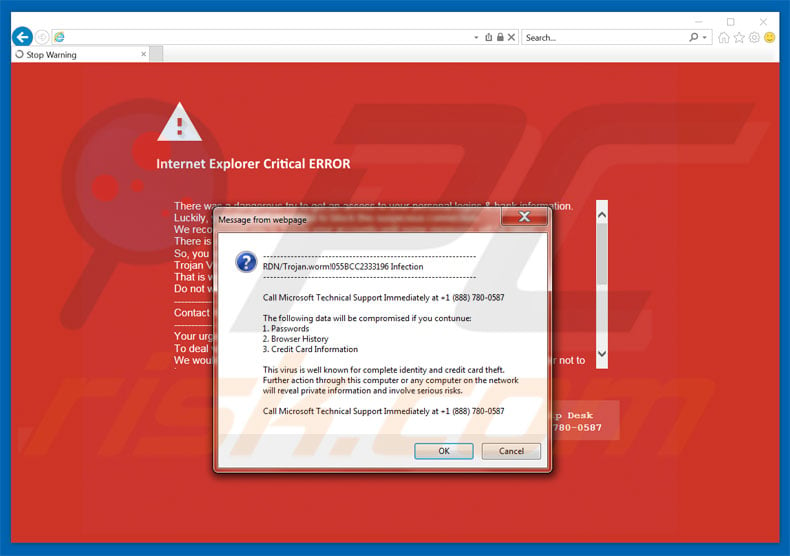
"Internet Explorer Critical ERROR" scam overview
The "Internet Explorer Critical ERROR" error states that the system is infected with a RDN/Trojan.worm virus and, therefore, personal information (logins/passwords, banking details, etc.) may be stolen.
It also states that the malware must be eliminated immediately by contacting Microsoft's "certified technicians" using one of the telephone numbers ("+1(888)-780-0587" or "+1(800)-757-326") provided. These technicians then supposedly guide users through the malware removal process. In fact, "Internet Explorer Critical ERROR" is fake and has nothing to do with Microsoft.
Cyber criminals claim to be certified technicians in an attempt to sell bogus services, which are not required. The malware does not exist. These people usually request remote computer access. Once connected, they stealthily change system settings and/or infiltrate malware. They then claim to find more issues and offer their help for additional fees.
For these reasons, never attempt to contact these people. Fake error-displaying websites and potentially unwanted programs might run various background processes (such as mining cryptocurrency), thus misusing computer resources and significantly diminishing overall performance. Potentially unwanted programs are also known to display various ads.
To achieve this, developers employ various tools that enable placement of third party graphical content on any site. Therefore, the ads often conceal underlying content, thus diminishing the browsing experience. In addition, they might redirect to malicious websites and/or run scripts designed to download and install PUPs/malware.
Therefore, clicking them can result in high-risk computer infections. Potentially unwanted programs also record user-system information (for example, IP addresses, websites visited, queries entered into search engines, mouse/keyboard activity, etc.) that might be personally identifiable.
PUP developers later sell this collected data to third parties (mostly for marketing purposes). For these reasons, potentially unwanted programs pose a direct threat to your privacy and Internet browsing safety. We strongly advise you to uninstall all PUPs immediately.
| Name | "Internet Explorer Critical ERROR" virus |
| Threat Type | Phishing, Scam, Social Engineering, Fraud |
| Tech Support Scammer Phone Number(s) | +1(888)-780-0587; +1(800)-757-326 |
| Symptoms | Fake error messages, fake system warnings, pop-up errors, hoax computer scan. |
| Distribution methods | Compromised websites, rogue online pop-up ads, potentially unwanted applications. |
| Damage | Loss of sensitive private information, monetary loss, identity theft, possible malware infections. |
| Malware Removal (Windows) |
To eliminate possible malware infections, scan your computer with legitimate antivirus software. Our security researchers recommend using Combo Cleaner. Download Combo CleanerTo use full-featured product, you have to purchase a license for Combo Cleaner. 7 days free trial available. Combo Cleaner is owned and operated by RCS LT, the parent company of PCRisk.com. |
As mentioned above, "Internet Explorer Critical ERROR" shares many similarities with dozens of other fake errors. All claim that the system is damaged, and yet, these false claims are merely attempts to scare and trick users into paying for technical support that is not required.
Potentially unwanted programs are also very similar. Most promise "useful features", however, they are useless for regular users.
Potentially unwanted programs are designed only to generate revenue for the developers. Rather than enabling the functions promised, PUPs usually promote malicious websites (by causing unwanted redirects), stealthily run unwanted processes, deliver malvertising ads (via the "Pay Per Click" advertising model), and gather various data.
How did adware install on my computer?
Although some PUPs have official download websites, most are distributed using malicious ads, together with a deceptive marketing method called "bundling" (stealth installation of third party apps with regular [mostly free] software). Therefore, most PUPs infiltrate systems without permission, or users install them inadvertently.
Developers are known to hide bundled programs within the "Custom/Advanced" options or other sections of the download/installation processes. Skipping download/installation steps and clicking advertisements often leads to inadvertent installation of rogue programs (users expose their systems to risk of various infections).
How to avoid installation of potentially unwanted applications?
Be aware that the main reasons for computer infections are poor knowledge and careless behavior. Therefore, be very careful when downloading/installing software and browsing the Internet. Carefully analyze each step of the download/installation processes (especially the "Custom/Advanced" settings) and decline all additionally-included programs.
Third party download/installation tools often bundle additional apps. Therefore, using these tools is very risky. We strongly advise you to download your software from official sources only and (if possible) using a direct download link.
Most malicious ads appear legitimate, however, they usually lead to adult dating, pornography, survey, gambling, and other suspicious websites. If you are redirected to such websites, avoid clicking ads and remove all suspicious programs/browser extensions. The key to computer safety is caution.
Text presented within the first pop-up:
Internet Explorer Critical ERROR
RDN/Trojan.worm!055BCC2333196 Infection
The following data will be compromised if you continue:
1. Passwords
2. Browser History
3. Credit Card Information
This virus is well known for complete identity and credit card theft. Further action through this computer or any computer on this network will reveal private information and involve serious risks.
Call Microsoft Technical Support Immediately at +1(888)780-0587
Screenshot of second "Internet Explorer Critical ERROR" pop-up:
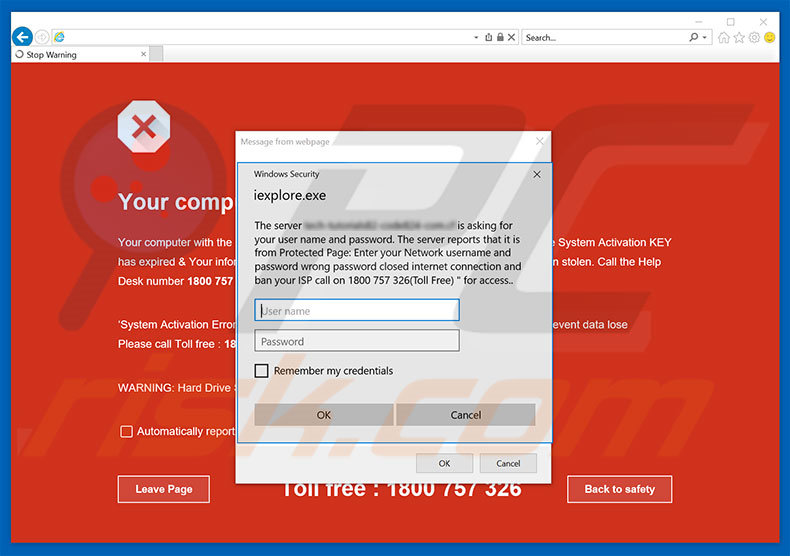
Text presented within the second pop-up:
The server reports that it is from Protected Page: Enter your Network username and password wrong password closed Internet connection and ban your ISP call on 1800 757 326 (Toll Free) for access…
Instant automatic malware removal:
Manual threat removal might be a lengthy and complicated process that requires advanced IT skills. Combo Cleaner is a professional automatic malware removal tool that is recommended to get rid of malware. Download it by clicking the button below:
DOWNLOAD Combo CleanerBy downloading any software listed on this website you agree to our Privacy Policy and Terms of Use. To use full-featured product, you have to purchase a license for Combo Cleaner. 7 days free trial available. Combo Cleaner is owned and operated by RCS LT, the parent company of PCRisk.com.
Quick menu:
- What is Internet Explorer Critical ERROR?
- STEP 1. Uninstall deceptive applications using Control Panel.
- STEP 2. Remove adware from Internet Explorer.
- STEP 3. Remove rogue extensions from Google Chrome.
- STEP 4. Remove potentially unwanted plug-ins from Mozilla Firefox.
- STEP 5. Remove rogue extensions from Safari.
- STEP 6. Remove rogue plug-ins from Microsoft Edge.
Adware removal:
Windows 11 users:

Right-click on the Start icon, select Apps and Features. In the opened window search for the application you want to uninstall, after locating it, click on the three vertical dots and select Uninstall.
Windows 10 users:

Right-click in the lower left corner of the screen, in the Quick Access Menu select Control Panel. In the opened window choose Programs and Features.
Windows 7 users:

Click Start (Windows Logo at the bottom left corner of your desktop), choose Control Panel. Locate Programs and click Uninstall a program.
macOS (OSX) users:

Click Finder, in the opened screen select Applications. Drag the app from the Applications folder to the Trash (located in your Dock), then right click the Trash icon and select Empty Trash.
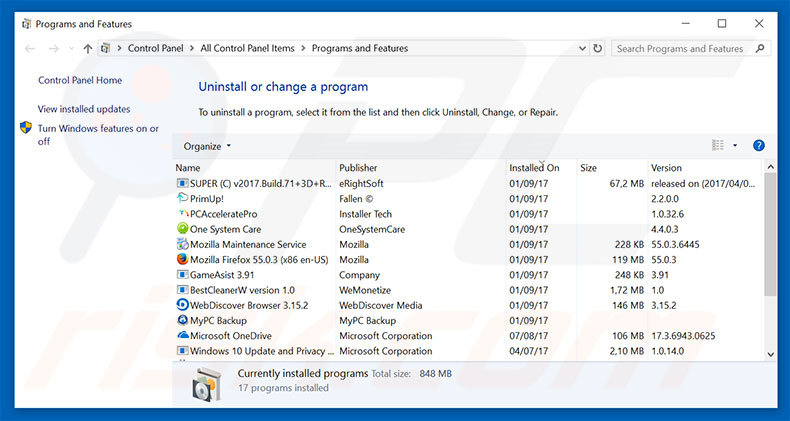
In the uninstall programs window, look for any suspicious/recently-installed applications, select these entries and click "Uninstall" or "Remove".
After uninstalling the potentially unwanted program, scan your computer for any remaining unwanted components or possible malware infections. To scan your computer, use recommended malware removal software.
DOWNLOAD remover for malware infections
Combo Cleaner checks if your computer is infected with malware. To use full-featured product, you have to purchase a license for Combo Cleaner. 7 days free trial available. Combo Cleaner is owned and operated by RCS LT, the parent company of PCRisk.com.
Remove adware from Internet browsers:
Video showing how to remove potentially unwanted browser add-ons:
 Remove malicious add-ons from Internet Explorer:
Remove malicious add-ons from Internet Explorer:
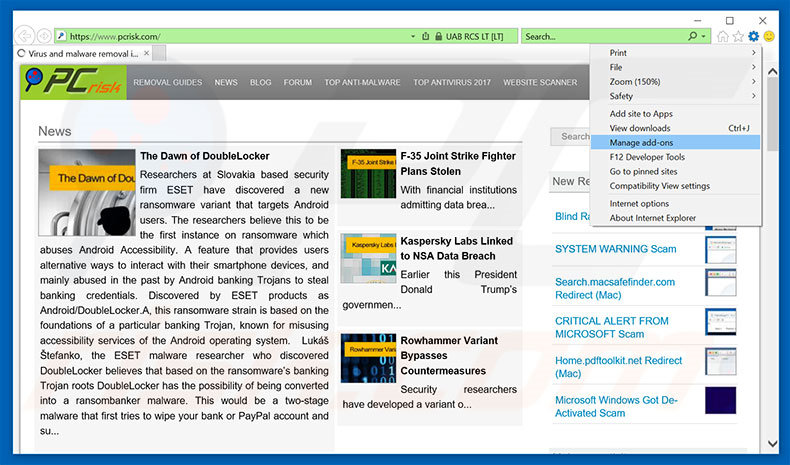
Click the "gear" icon ![]() (at the top right corner of Internet Explorer), select "Manage Add-ons". Look for any recently-installed suspicious browser extensions, select these entries and click "Remove".
(at the top right corner of Internet Explorer), select "Manage Add-ons". Look for any recently-installed suspicious browser extensions, select these entries and click "Remove".
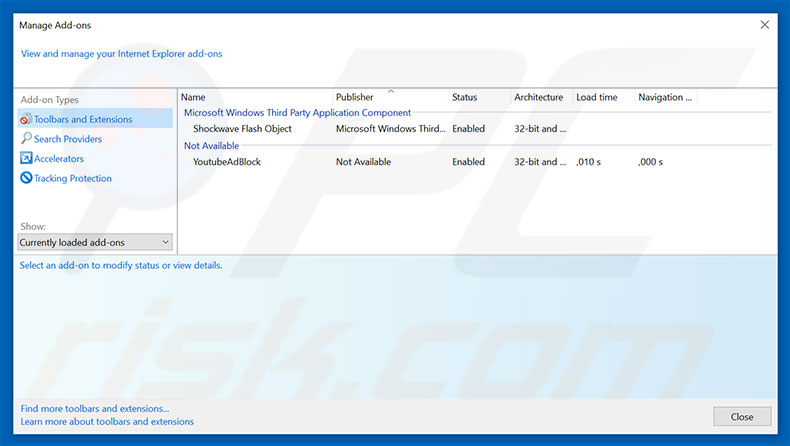
Optional method:
If you continue to have problems with removal of the "internet explorer critical error" virus, reset your Internet Explorer settings to default.
Windows XP users: Click Start, click Run, in the opened window type inetcpl.cpl In the opened window click the Advanced tab, then click Reset.

Windows Vista and Windows 7 users: Click the Windows logo, in the start search box type inetcpl.cpl and click enter. In the opened window click the Advanced tab, then click Reset.

Windows 8 users: Open Internet Explorer and click the gear icon. Select Internet Options.

In the opened window, select the Advanced tab.

Click the Reset button.

Confirm that you wish to reset Internet Explorer settings to default by clicking the Reset button.

 Remove malicious extensions from Google Chrome:
Remove malicious extensions from Google Chrome:
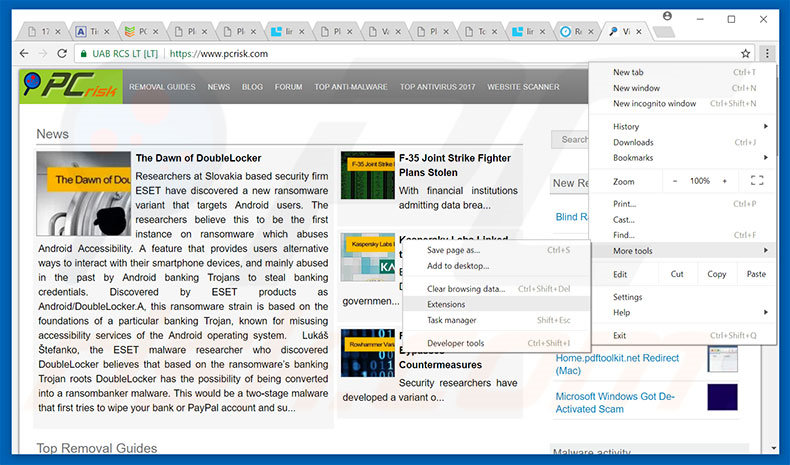
Click the Chrome menu icon ![]() (at the top right corner of Google Chrome), select "More tools" and click "Extensions". Locate all recently-installed suspicious browser add-ons, select these entries and click the trash can icon.
(at the top right corner of Google Chrome), select "More tools" and click "Extensions". Locate all recently-installed suspicious browser add-ons, select these entries and click the trash can icon.
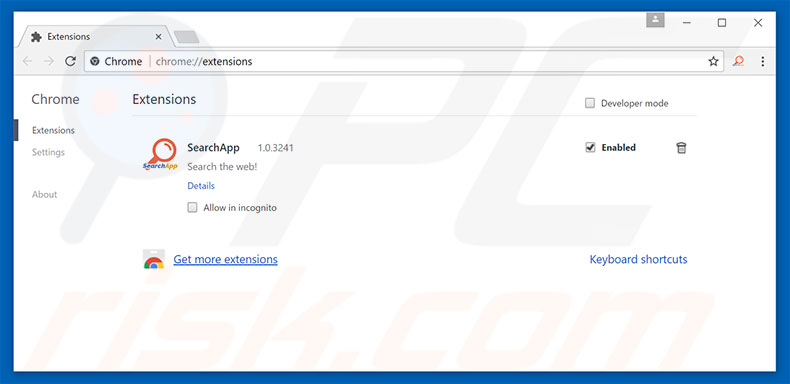
Optional method:
If you continue to have problems with removal of the "internet explorer critical error" virus, reset your Google Chrome browser settings. Click the Chrome menu icon ![]() (at the top right corner of Google Chrome) and select Settings. Scroll down to the bottom of the screen. Click the Advanced… link.
(at the top right corner of Google Chrome) and select Settings. Scroll down to the bottom of the screen. Click the Advanced… link.

After scrolling to the bottom of the screen, click the Reset (Restore settings to their original defaults) button.

In the opened window, confirm that you wish to reset Google Chrome settings to default by clicking the Reset button.

 Remove malicious plug-ins from Mozilla Firefox:
Remove malicious plug-ins from Mozilla Firefox:
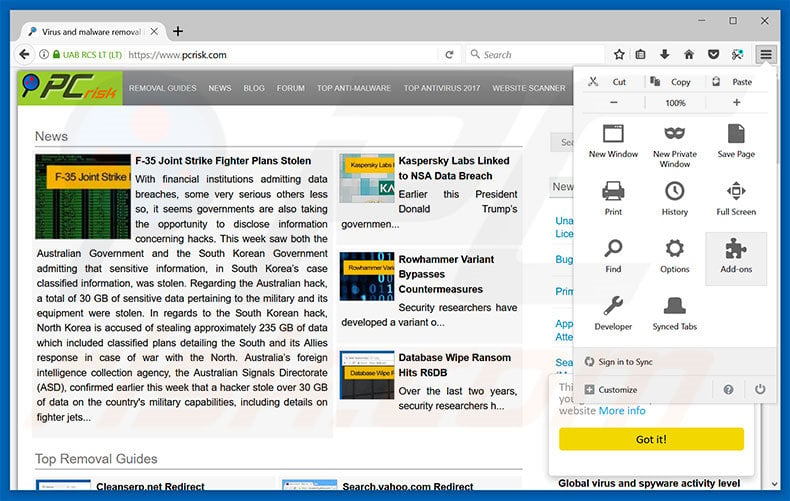
Click the Firefox menu ![]() (at the top right corner of the main window), select "Add-ons". Click "Extensions", in the opened window, remove all recently-installed suspicious browser plug-ins.
(at the top right corner of the main window), select "Add-ons". Click "Extensions", in the opened window, remove all recently-installed suspicious browser plug-ins.
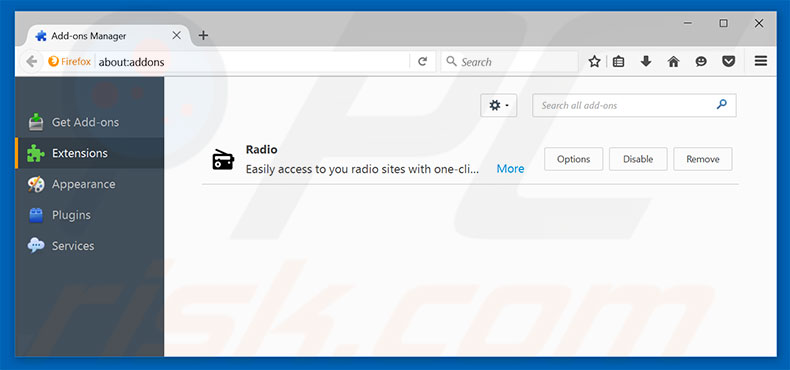
Optional method:
Computer users who have problems with "internet explorer critical error" virus removal can reset their Mozilla Firefox settings.
Open Mozilla Firefox, at the top right corner of the main window, click the Firefox menu, ![]() in the opened menu, click Help.
in the opened menu, click Help.

Select Troubleshooting Information.

In the opened window, click the Refresh Firefox button.

In the opened window, confirm that you wish to reset Mozilla Firefox settings to default by clicking the Refresh Firefox button.

 Remove malicious extensions from Safari:
Remove malicious extensions from Safari:

Make sure your Safari browser is active, click Safari menu, and select Preferences....

In the opened window click Extensions, locate any recently installed suspicious extension, select it and click Uninstall.
Optional method:
Make sure your Safari browser is active and click on Safari menu. From the drop down menu select Clear History and Website Data...

In the opened window select all history and click the Clear History button.

 Remove malicious extensions from Microsoft Edge:
Remove malicious extensions from Microsoft Edge:

Click the Edge menu icon ![]() (at the upper-right corner of Microsoft Edge), select "Extensions". Locate all recently-installed suspicious browser add-ons and click "Remove" below their names.
(at the upper-right corner of Microsoft Edge), select "Extensions". Locate all recently-installed suspicious browser add-ons and click "Remove" below their names.

Optional method:
If you continue to have problems with removal of the "internet explorer critical error" virus, reset your Microsoft Edge browser settings. Click the Edge menu icon ![]() (at the top right corner of Microsoft Edge) and select Settings.
(at the top right corner of Microsoft Edge) and select Settings.

In the opened settings menu select Reset settings.

Select Restore settings to their default values. In the opened window, confirm that you wish to reset Microsoft Edge settings to default by clicking the Reset button.

- If this did not help, follow these alternative instructions explaining how to reset the Microsoft Edge browser.
Summary:
 Commonly, adware or potentially unwanted applications infiltrate Internet browsers through free software downloads. Note that the safest source for downloading free software is via developers' websites only. To avoid installation of adware, be very attentive when downloading and installing free software. When installing previously-downloaded free programs, choose the custom or advanced installation options – this step will reveal any potentially unwanted applications listed for installation together with your chosen free program.
Commonly, adware or potentially unwanted applications infiltrate Internet browsers through free software downloads. Note that the safest source for downloading free software is via developers' websites only. To avoid installation of adware, be very attentive when downloading and installing free software. When installing previously-downloaded free programs, choose the custom or advanced installation options – this step will reveal any potentially unwanted applications listed for installation together with your chosen free program.
Post a comment:
If you have additional information on "internet explorer critical error" virus or it's removal please share your knowledge in the comments section below.
Frequently Asked Questions (FAQ)
What is an online scam?
An online scam is a type of deceptive content promoted on the Web. Its purpose is to deceive users into performing specific actions, e.g., calling fake helplines, allowing cyber criminals to access computers remotely, disclosing sensitive information, sending money, purchasing products, subscribing to services, downloading/installing software, and so forth.
What is the purpose of an online scam?
Online scams aim to generate revenue at victims' expense. Profit can be made by obtaining funds through deception, endorsing content (e.g., websites, software, products, services, etc.), abusing/selling private information, and distributing malware.
Why do I encounter online scams?
Online scams are primarily promoted via websites that employ rogue advertising networks, misspelled URLs, spam (e.g., emails, social media posts, DMs/PMs, SMSes, browser notifications, etc.), intrusive ads, and adware.
I cannot exit a scam page, how do I close it?
If you cannot close a deceptive webpage, use the Task Manager to end the browser's process. When re-accessing the browser, start a new browsing session – as restoring the previous one will reopen the scam page.
I have allowed cyber criminals to remotely access my computer, what should I do?
If you have permitted cyber criminals to access your device remotely, you must first disconnect it from the Internet. Afterward, remove the remote access program that the criminals used (e.g., UltraViewer, TeamViewer, etc.), as they might not need your consent to reconnect. Lastly, run a full system scan with an anti-virus and remove all detected threats.
I have provided my personal information when tricked by an online scam, what should I do?
If you have provided your log-in credentials – change the passwords of all possibly exposed accounts and inform their official support. However, if the disclosed information was of a different personal nature (e.g., passport photos/scans, ID card details, debit/credit card numbers, etc.) – immediately contact relevant authorities.
Will Combo Cleaner protect me from online scams and the malware they proliferate?
Combo Cleaner is designed to detect and eliminate all kinds of threats. It is capable of scanning visited websites for deceptive and malicious content. If such a page is opened – Combo Cleaner will issue immediate warnings and block further access to it.
Furthermore, Combo Cleaner can detect and remove practically all known malware infections. Note that performing a complete system scan is essential since high-end malicious software usually hides deep within systems.
Share:

Tomas Meskauskas
Expert security researcher, professional malware analyst
I am passionate about computer security and technology. I have an experience of over 10 years working in various companies related to computer technical issue solving and Internet security. I have been working as an author and editor for pcrisk.com since 2010. Follow me on Twitter and LinkedIn to stay informed about the latest online security threats.
PCrisk security portal is brought by a company RCS LT.
Joined forces of security researchers help educate computer users about the latest online security threats. More information about the company RCS LT.
Our malware removal guides are free. However, if you want to support us you can send us a donation.
DonatePCrisk security portal is brought by a company RCS LT.
Joined forces of security researchers help educate computer users about the latest online security threats. More information about the company RCS LT.
Our malware removal guides are free. However, if you want to support us you can send us a donation.
Donate
▼ Show Discussion